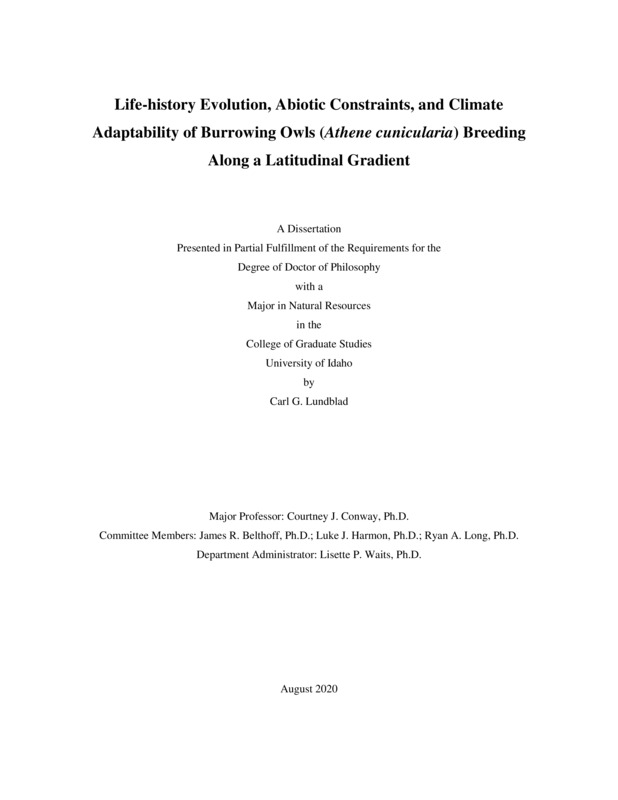Life-history Evolution, Abiotic Constraints, and Climate Adaptability of Burrowing Owls (Athene cunicularia) Breeding Along a Latitudinal Gradient
Lundblad, Carl Gregory. (2020-08). Life-history Evolution, Abiotic Constraints, and Climate Adaptability of Burrowing Owls (Athene cunicularia) Breeding Along a Latitudinal Gradient. Theses and Dissertations Collection, University of Idaho Library Digital Collections. https://www.lib.uidaho.edu/digital/etd/items/lundblad_idaho_0089e_11887.html
- Title:
- Life-history Evolution, Abiotic Constraints, and Climate Adaptability of Burrowing Owls (Athene cunicularia) Breeding Along a Latitudinal Gradient
- Author:
- Lundblad, Carl Gregory
- ORCID:
- 0000-0001-7925-9055
- Date:
- 2020-08
- Program:
- Natural Resources
- Subject Category:
- Ecology; Zoology; Wildlife management
- Abstract:
-
Two of the most prominent contemporary goals of ecology are to: 1) understand how populations are regulated through variation in the rates of births and deaths and, 2) to elucidate, anticipate, and mitigate the impacts of climate change and other environmental changes on wildlife populations. These two objectives are inherently linked because to fully understand how populations will respond to climate change, we first need an improved understanding of how they are currently adapted to their thermal environment. However, the extent to which fitness is directly linked to the abiotic environment and the specific mechanisms that mediate those relationships are often poorly understood. Therefore, we need a more detailed understanding of the patterns and drivers of life-history variation and the ways in which such variation is driven by thermal effects.
I examined intraspecific patterns and causes of life-history variation within a single widespread species, the Burrowing Owl (Athene cunicularia), breeding along a 1400-km latitudinal gradient in western North America from 2015 – 2018. My overall objectives were to: 1) document latitudinal and other patterns of variation in a large suite of life-history traits and breeding behaviors, 2) test mechanistic hypotheses to explain that variation with an emphasis on examining abiotic and thermal mechanisms, and 3) understand the complex trade-offs and interactions among traits, activities, and allocation decisions occurring at different stages of the avian reproductive cycle. We used motion-activated video recording inside of occupied Burrowing Owl nests to gain detailed data on the reproductive behaviors of Burrowing Owls across all stages of the reproductive cycle.
Chapter Two documents latitudinal patterns in a suite of traits related to hatching patterns and hatching asynchrony, tests a thermally-based hypothesis to explain the cause of asynchronous hatching, and considers whether the same mechanism responsible for asynchronous hatching might also explain the latitudinal variation in clutch size. We found that most traits varied clinally with latitude, but all the traits were more strongly associated with individual nest microclimates than with latitude, and all in the directions predicted by the egg viability hypothesis. These results suggest that abiotic conditions in the nest drive an important life-history tradeoff and that thermal gradients are sufficient to account for observed biogeographic and seasonal patterns in life-history strategies.
Chapter Three documents latitudinal variation in egg-laying behaviors and tests hypotheses to explain variation in laying interval. Burrowing Owls laid eggs at all times of day but laid more eggs in the morning hours, and that tendency was strongest among first eggs in a clutch (i.e., nest initiation times). Laying interval duration varied dramatically, was negatively correlated with latitude, and was associated with burrow temperature and with numerous behavioral and life-history traits. Our results indicate that laying interval is not a fixed constraint on avian reproduction but rather should be considered an important life-history trait in future studies.
Chapter Four documents latitudinal variation in incubation behavior, examines patterns and sources of variation in nest attentiveness, and uses a hypothetico-deductive approach to test a pair of alternative hypotheses to explain variation in incubation period length. Daily nest attentiveness, cumulative nest attendance, and incubation period duration all increased with increasing latitude, but that variation could be accounted for by predicted life-history tradeoffs. Burrowing Owls reduced their daily attentiveness on days that the average burrow temperature was within the range that is optimal for embryo development. Finally, variation in incubation periods was best explained by cumulative nest attendance instead of daily nest attentiveness suggesting that variation in incubation periods is driven by differential selection on neonate quality, as suggested by the neonate quality hypothesis.
Chapter Five reviews the historical development of “Ashmole’s hypothesis” of clutch size evolution, which is based in a simple abiotic mechanism driven by seasonality of productivity. I summarize the empirical evidence in support and against Ashmole’s hypothesis, and then discuss and clarify numerous sources of confusion in the existing literature surrounding the hypothesis. As a whole, this dissertation documents numerous biogeographic patterns in avian life-histories that have heretofore been unknown or poorly documented, it provides new insights into the drivers of that variation in into the drivers of life-history variation generally, and it identifies mechanisms by which avian reproduction is adapted to the abiotic environment and may therefore respond to climate change.
- Description:
- doctoral, Ph.D., Natural Resources -- University of Idaho - College of Graduate Studies, 2020-08
- Major Professor:
- Conway, Courtney J
- Committee:
- Belthoff, James R; Harmon, Luke J; Long, Ryan A
- Defense Date:
- 2020-08
- Identifier:
- Lundblad_idaho_0089E_11887
- Type:
- Text
- Format Original:
- Format:
- application/pdf
- Rights:
- In Copyright - Educational Use Permitted. For more information, please contact University of Idaho Library Special Collections and Archives Department at libspec@uidaho.edu.
- Standardized Rights:
- http://rightsstatements.org/vocab/InC-EDU/1.0/

